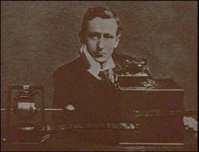 BIG BROTHER
BIG BROTHER
 BIG BROTHER
BIG BROTHER
I know what you're thinking,
another conspiracy theorist with paranoia delusions about
being monitored by the state. Wrong!
An odd ball that has watched one 'X Files' too many.
Wrong again!
As stated on the home page, 'we' are none of these things.
All I am going to do
is to enter into a dialogue where what you think of as everyday
occurrences, incidences and
observations which
make up modern life, are shown from a different
and neutral perspective.
I will also include a brief history of electronic communications
in this brave new world.
You can then decide for yourselves as to question "Is big
brother watching you?"
On May 24th, 1844, an
American artist and inventor called Samuel Morse (1791-1872) sent
the first telegraph message from the Supreme Court Chamber of
the U.S. Capitol Building in Washington D.C.
to a receiver in Baltimore, some 65 km away.
In 1873, a brilliant
Scottish mathematician called James Maxwell (1831-1879) published
his 'Treatise on Electricity and Magnetism'
which is one of the greatest achievements of 19th-century
physics.
Without Maxwell's work, radio and television could not exist as
they rely on radio waves to carry sound and video signals.
On March 10, 1876, Graham Bell made the first phone call to his assistant, Thomas Watson, from one room to another. The message was:"Mr Watson, please come here. I want you!"
Maxwell's theory was proved right in 1887 when Heinrich Hertz (1857-1894) made the first radio transmitter and demonstrated the existence of radio waves.
 Guglielmo
Marconi (1874-1937), known as the father of wireless, was fascinated
by the idea of using waves to communicate.
Guglielmo
Marconi (1874-1937), known as the father of wireless, was fascinated
by the idea of using waves to communicate.
He discovered a way to transmit and receive radio waves and perfected
it during the 1890s.
On December 1901, Marconi proved to the world that it was possible
to send messages across continents when he sent the letter "S"
in Morse from Cornwall, England to St. John's, Newfoundland in
Canada.
John Logie Baird had the first success with transmitted images in the 1920's.
The first televisions
were developed during the 1920s and perfected in the 1930s.
The first "successful" colour television was invented
in 1953.
Many satellites were developed and launched in the late 1950s and in the 1960s, for observation or spying...
After several tries
("Echo1") , in July 1962, NASA launched the first
public telecommunications satellite "Telstar" and broadcast
the first live television pictures across the Atlantic.
However its orbit was low and the ground stations could not maintain
permanent contact.